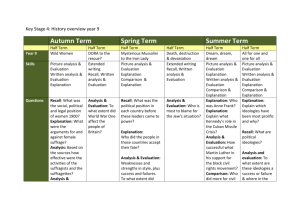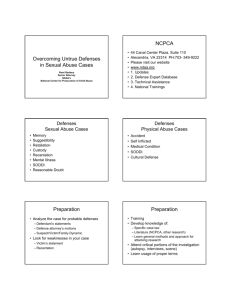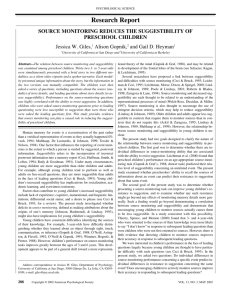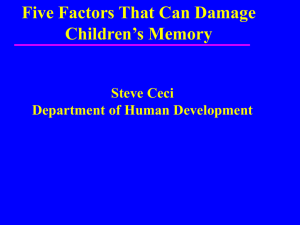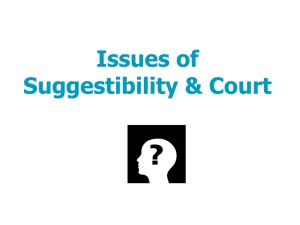Children's Recall and Testimony
advertisement
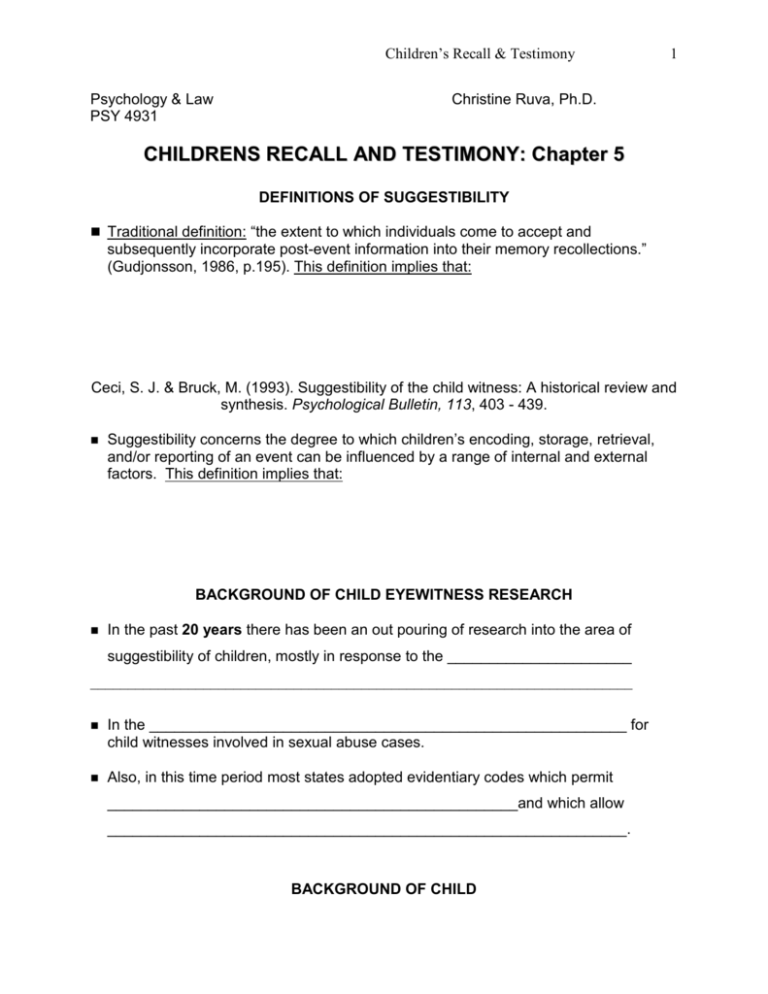
Children’s Recall & Testimony Psychology & Law PSY 4931 1 Christine Ruva, Ph.D. CHILDRENS RECALL AND TESTIMONY: Chapter 5 DEFINITIONS OF SUGGESTIBILITY Traditional definition: “the extent to which individuals come to accept and subsequently incorporate post-event information into their memory recollections.” (Gudjonsson, 1986, p.195). This definition implies that: Ceci, S. J. & Bruck, M. (1993). Suggestibility of the child witness: A historical review and synthesis. Psychological Bulletin, 113, 403 - 439. Suggestibility concerns the degree to which children’s encoding, storage, retrieval, and/or reporting of an event can be influenced by a range of internal and external factors. This definition implies that: BACKGROUND OF CHILD EYEWITNESS RESEARCH In the past 20 years there has been an out pouring of research into the area of suggestibility of children, mostly in response to the ______________________ ________________________________________________________________________ In the _________________________________________________________ for child witnesses involved in sexual abuse cases. Also, in this time period most states adopted evidentiary codes which permit _________________________________________________and which allow ______________________________________________________________. BACKGROUND OF CHILD Children’s Recall & Testimony EYEWITNESS RESEARCH There is an emotional battle being waged today in our nation’s courtrooms, universities, and professional societies revolving around the credibility of children’s testimony. To listen to one side, one would think that everything that a child tells a social worker or therapist must be believed. To listen to the other side in this battle, one would think that because young children are more vulnerable to erroneous suggestions and social demands than older children and adults, they should not be believed when they claim to have been sexually molested. The Question: Can young children accurately recall and provide testimony for an event they have witnessed or participated in? The Answer? Your textbook separates children’s recall performance under 2 conditions: Recall For Experienced Events When Contaminating Influences Are Not Present Young children’s (< 7 years) memory reports are impoverished when open-ended questioning is used. The majority of 3- to 4-year-olds may say nothing about target events, even immediately after those events have occurred. The reasons for these impoverished reports are many: 2 Children’s Recall & Testimony VARIABLES THAT AFFECT THE SUGGESTIBILITY OF YOUNG CHILDREN FORM OF QUESTION Impoverished memory reports when free recall is used . . What they do recall Less accurate than older children & adults when answering _______________ ___________________________________________________ Why are young children more suggestible . . .? REPEATED QUESTIONING Wee Care Preschool interviewers for the Kelly Michaels investigations Mouse Trap Study Ceci, Huffman (Crotteau), Smith, & Loftus (1994) Participants: 3-4 years (young group) or 5-6 years (old group) Procedure: interviewed on at least 7 occasions. Fictitious events: Children were asked to recollect the events on ____________________ spaced on average approximately ______________________________. At the last session a _________________________ asked the children for a _______________________about each of the real and imagined events. 3 Children’s Recall & Testimony 4 Mouse Trap Study Results By the seventh interview the false memory rates were: younger (3-4 years) = older (5-6 years) = Children’s reports of the false events increased in _____________________ and amount of _________________________________ over time. Mouse Trap Study ABC’s 20/20 interview with John Stossel Several weeks after the final interview a 4-year-old child was interviewed by John Stossel. The child’s mother told the researchers that she had thought the experiment was over ... When John Stossel asked the child if he ever gotten got his finger caught in a mousetrap and had to go to the hospital to get it off he ... VARIABLES THAT AFFECT THE SUGGESTIBILITY OF YOUNG CHILDREN: STATUS OF THE SOURCE OF THE MISINFORMATION Wee Care Preschool interviewers for the Kelly Michaels investigations Tobey & Goodman (1992) 4 year olds played with a baby sitter and were interviewed about this event 11 days later. Interviewer status was manipulated: half of the children spoke to a __________________________ and half were interviewed by a___________________________. Children’s Recall & Testimony 5 Tobey & Goodman (1992): Results THE EFFECTS OF INTERVIEWER BIAS EFFECTS ON CHILDREN’S MEMORY REPORTS: Pettit, Fegan, and Howie (1990) Method 2 actors posing as park rangers visited the classes of preschool children: cake fell on floor. 7 children were taken to a separate room, and did not witness the event. 2 weeks later, all the children were questioned about the event. Interviewers beliefs were manipulated: accurate, inaccurate, or no information. Pettit, Fegan, and Howie (1990): Results THE EFFECTS OF PRIOR INFORMATION (STEREOTYPES) ON CHILDREN’S MEMORY REPORTS Sam Stone (SS) Study: Leichtman & Ceci (1995) “SAM STONE” visited preschoolers (3-6 yrs) Interviewed on 4 different occasions over a 10-week period. One month following the 4th interview a different interviewer asked about 2 nonevents involving Sam Stone: Children’s Recall & Testimony 6 Sam Stone Study: Leichtman & Ceci (1995) 4 Conditions Control Group: Suggestion group: Stereotype only condition: Stereotype & plus suggestion condition: The 5th interview was the same for all of the children Sam Stone Study: Results COULD EXPERTS DISTINGUISH BETWEEN CHILDREN’S ACCURATE AND INACCURATE MEMORY REPORTS? They presented videotapes of three of their participants (a three-year-old, a four-yearold, and a five-year-old) 119 researchers and clinicians who work in the area of children's testimony. They showed the same videotapes to over 1500 psychiatrists, social workers, and clinical psychologist at several professional meetings during 1994 through 1995. They showed the videotapes of 10 children from the Mouse Trap Study to professionals. In a separate study 20 of the true and false reports from the same final interview of the Mouse Trap Study were given to four experts who specialize in children’s statement validity analysis. HOW CAN AN INTERVIEWER OBTAIN VERIDICAL ACCOUNTS FROM CHILDREN?





